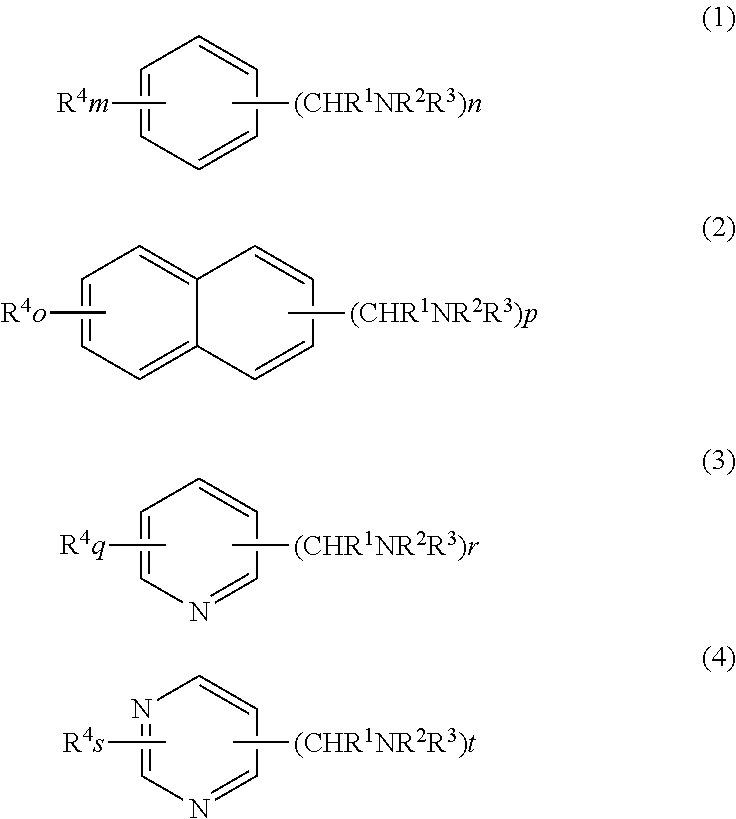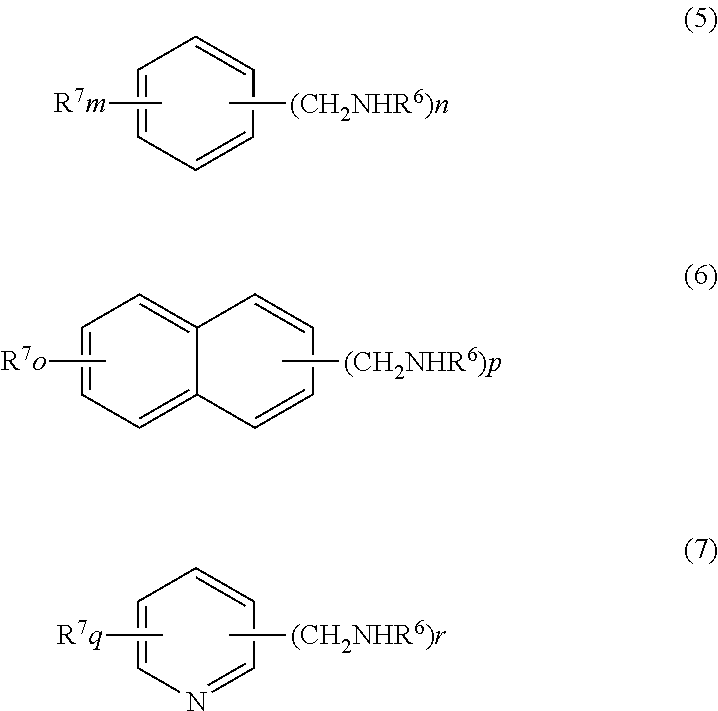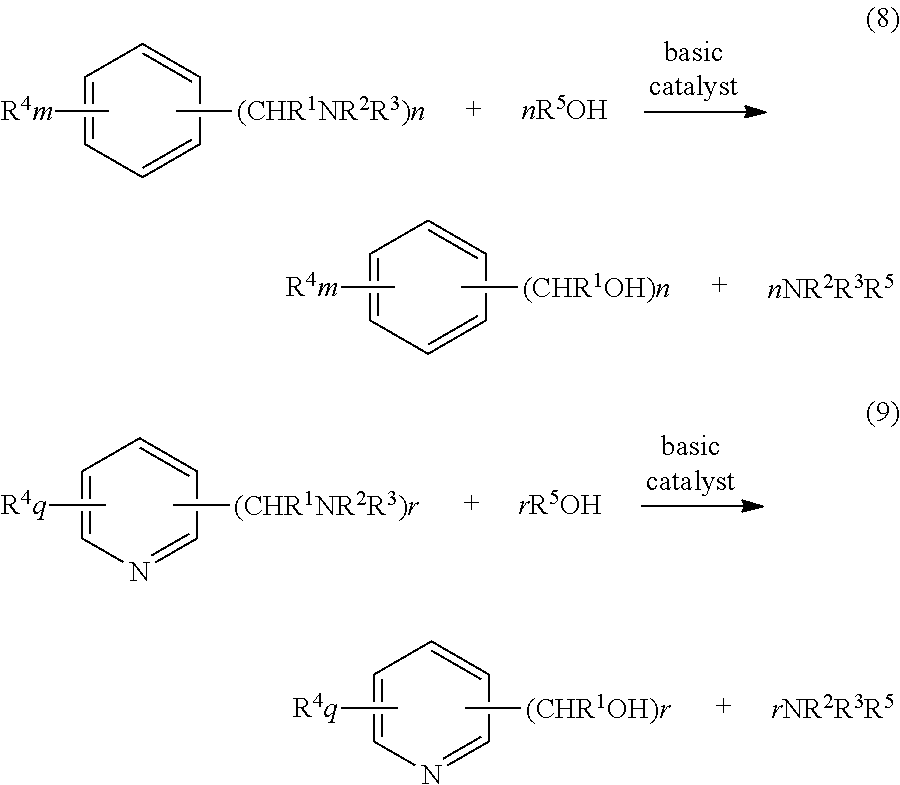Process for production of aromatic alcohol or heterocyclic aromatic alcohol
a technology of aromatic alcohol and heterocyclic aromatic alcohol, which is applied in the direction of physical/chemical process catalysts, metal/metal-oxide/metal-hydroxide catalysts, organic chemistry, etc., can solve the problems of equipment corrosion, salt treatment, and not always suitable industrial production, and achieves suppressing side reactions and enhancing selectivity. , the effect of high efficiency
- Summary
- Abstract
- Description
- Claims
- Application Information
AI Technical Summary
Benefits of technology
Problems solved by technology
Method used
Image
Examples
example 1
[0042]In a stainless steel pressure resistant vessel having an inner capacity of 40 mL equipped with a thermometer and a manometer, 0.30 g of m-xylylenediamine, 7.50 g of methanol and 0.10 g of sodium hydroxide were charged, and the vessel was sealed under a nitrogen atmosphere. The mixture was heated and held at 240° C. for 2 hours. After cooling, the reaction solution was taken out, and after neutralizing sodium hydroxide, was analyzed. The conversion ratio of m-xylylenediamine was 100%, and the yield of m-xylylene glycol was 73%.
examples 6 to 25
[0045]In a stainless steel pressure resistant vessel having an inner capacity of 40 mL equipped with a thermometer and a manometer, the amine shown in Table 2 below was charged along with methanol, water and sodium hydroxide at a molar ratio of amine / methanol / water / sodium hydroxide of 1 / 110 / 70 / 1.4, and the vessel was sealed under a nitrogen atmosphere. The mixture was heated and held at 240° C. for 2 hours. After cooling, the reaction solution was taken out, and after neutralizing sodium hydroxide, was analyzed. The results are shown in Table 2.
[0046]
TABLE 2Conversionratio of rawAminematerial (%)Alcohol formedYield (%)Example 6 benzylamine100benzyl alcohol91Example 7 N-methylbenzylamine16benzyl alcohol6Example 8 dibenzylamine6benzyl alcohol4Example 9 N,N-dimethylbenzylamine16benzyl alcohol2Example 101-phenylethylamine411-phenylethanol23Example 11o-methylbenzylamine100o-methylbenzyl alcohol92Example 12m-methylbenzylamine100m-methylbenzyl alcohol93Example 13p-methylbenzylamine100p-met...
examples 26 to 29
[0047]In a stainless steel pressure resistant vessel having an inner capacity of 40 mL equipped with a thermometer and a manometer, the amine shown in Table 3 below was charged along with methanol, water and sodium hydroxide at a molar ratio of amine / methanol / water / sodium hydroxide of 1 / 55 / 35 / 0.7, and the vessel was sealed under a nitrogen atmosphere. The mixture was heated and held at 240° C. for 2 hours. After cooling, the reaction solution was taken out, and after neutralizing sodium hydroxide, was analyzed. The results are shown in Table 3.
[0048]
TABLE 3Conversionratio of rawAromatic aminematerial (%)Alcohol formedYield (%)Example 26benzylamine100benzyl alcohol96Example 27o-methoxybenzylamine97o-methoxybenzyl alcohol48Example 28m-methoxybenzylamine100m-methoxybenzyl alcohol65Example 29m-chlorobenzylamine100m-chlorobenzyl alcohol91Example 304-(dimethylamino)benzylamine924-dimethylaminobenzyl alcohol12dihydrochlorideExample 31p-xylylenediamine100p-xylylene glycol22
PUM
| Property | Measurement | Unit |
|---|---|---|
| molar ratio | aaaaa | aaaaa |
| molar ratio | aaaaa | aaaaa |
| molar ratio | aaaaa | aaaaa |
Abstract
Description
Claims
Application Information
 Login to View More
Login to View More - R&D
- Intellectual Property
- Life Sciences
- Materials
- Tech Scout
- Unparalleled Data Quality
- Higher Quality Content
- 60% Fewer Hallucinations
Browse by: Latest US Patents, China's latest patents, Technical Efficacy Thesaurus, Application Domain, Technology Topic, Popular Technical Reports.
© 2025 PatSnap. All rights reserved.Legal|Privacy policy|Modern Slavery Act Transparency Statement|Sitemap|About US| Contact US: help@patsnap.com



